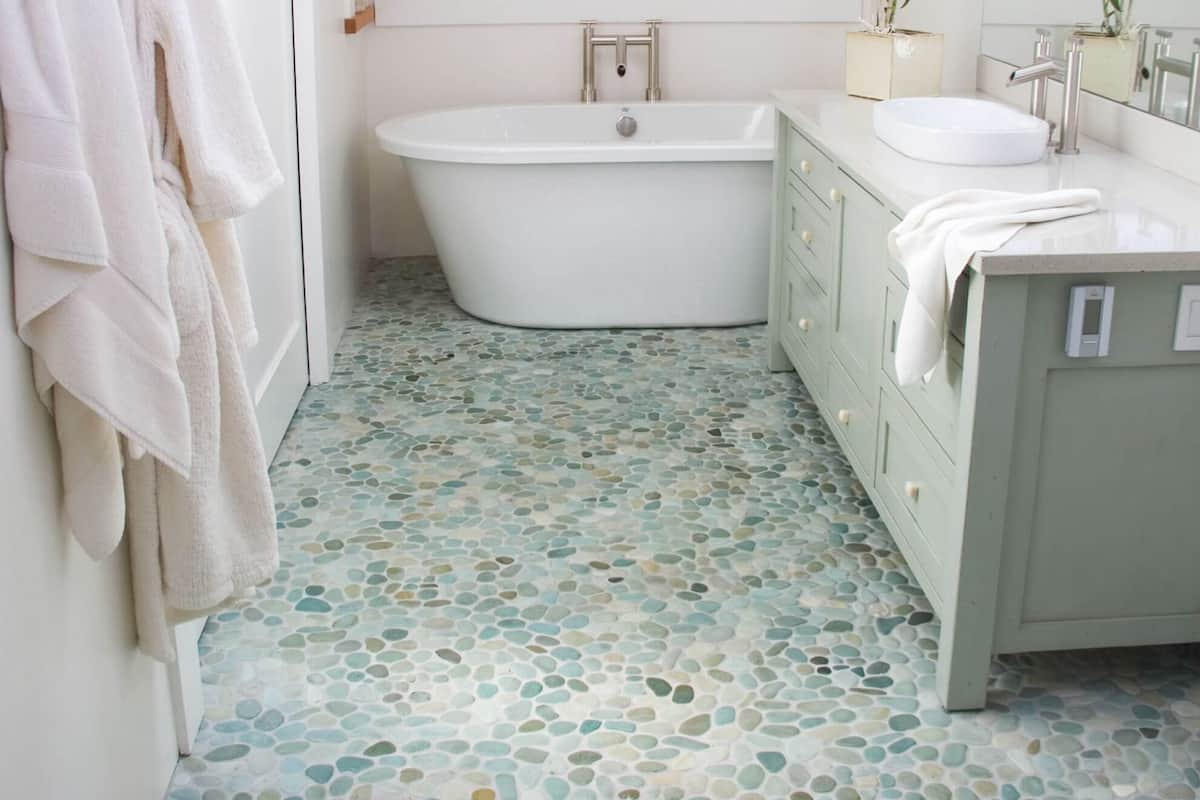A surprising variety of materials are available for bathroom floor tiles. For a good reason, ceramic, porcelain, and vinyl tiles are frequent types of first that come to mind: They're arguably the most practical and best options available to design what you think. But today, there are numerous possibilities, like cork and stone. The most crucial considerations when choosing a flooring material are making sure that it won't be dangerously slick when wet and that moisture won't seep beneath the surface and cause harm. The final decision usually involves striking a balance between style and price after that. This guide to the best tile for a bathroom floor will help you learn about all your alternatives, making choosing easier.

Vinyl Floor TilesBecause of its low cost and great level of functionality, vinyl is the most preferred bathroom flooring material. From the master bath to the powder room, it works nicely in every bathroom in the house. It clearly outperforms other popular options in terms of durability, comfort, and safety. Almost as important, the best producers of vinyl tiles have come a long way in visual appeal and ease of installation. The material may be cut with a standard utility knife and self-adhering. The starting price per square foot is $2.50. Tiles made of ceramic and porcelainWhether your tastes lean toward colorful penny tiles, lattice-patterned squares, or stone or wood imitations, you're sure to discover that ceramic and porcelain tile selections are among the best for bathroom floor tile. Ceramics perform well in terms of upkeep, just like vinyl, but they are not nearly as comfy for bare feet. Radiant floor heating can assist in changing that, but a hard surface is still hard whether it's warm or not. Ceramics are more difficult to install than vinyl, but an enterprising do-it-yourselfer can nonetheless complete the task. Ceramics will withstand wear and scratches if it is coated with an excellent glaze. If there is chipping, a benefit is that porcelain tiles have a potential for through-body color and are tougher than clay-based tiles.

Make sure ceramic or porcelain tile is approved for usage on floors before purchasing.For floors, pick ceramic tile with a grade of 1 or 2. Additionally, there is a coefficient of friction for ceramic tile (COF). Choose one rated.50 or above to reduce the risk of slides in this damp area. Choose tiles that are at least PEI III in the Porcelain Enamel Institute (PEI) rating standard.Ceramic tile costs start at about $0.50 per square foot, and porcelain tile costs start at $3 per square foot. Glass tilesTwo things make glass floor tiles aesthetically pleasing: The appearance of depth and, if colored, a magnificent stained-glass effect are produced by covering a portion of the floor in a thin coating of glass. When installed correctly, this sort of tile endures well; however, to avoid slips, choose floor-rated tile and textured glass. Also, non-slip are little glass tiles with numerous grout joints. With these suggestions in mind, think of decorating a shower floor (and possibly the sides, too) with tiny glass tile squares to make a focal point in the bathroom. The starting price is about $5 per square foot.Stone tilesThe entryway used to be the only place with stone tiles. However, they have become more common in recent years in a variety of spaces, including bathrooms.

Stone tiles come in a variety of hues, from cream to blues, reds, greens, and gold, and are made of limestone, marble, granite, and slate. Nearly as many textures are available, with variants in the cleft, tumbled, sandblasted, etched, and flamed finishes. Usually, stone costs more than ceramic or porcelain tiles that seem identical. Additionally, naturally porous stone needs more upkeep than ceramic tile; routine cleaning and sealing are advised. (See our suggestions for the top marble and granite sealers to protect your investment.) Costs vary. Laminate Plastic Tiles A nice option is plastic laminate tiles, which are more frequently found as planks, especially if you're redecorating. The tiles don't greatly increase the height of the current floor, similar to the laminate material that covered kitchen worktops for a generation or two; this makes it simpler to plan transitions from one room to another. Laminate does not stand up well to moisture despite being sturdy and simple to keep clean. For one tile, a half-bath may be preferable to a full bath since standing water can seep into the fiberboard core, causing the material to expand and buckle. Caulking cracks around the walls, around the toilet, and (if in a full bathroom) the tub is essential when using laminates to stop water infiltration. Another drawback is that laminates don't offer as many different stylistic options as ceramic and vinyl do.The starting price per square foot is $1.

Tiles made of linoleumLinseed oil, cork powder, wood flour, crushed limestone, and colors are the ingredients used to make linoleum. It works well in bathrooms and looks great in modern or vintage settings. It is praised for its ability to naturally resist dirt and dust while also preventing the growth of microbes, all while maintaining its color. It is simple to install because of the click-in-place plank designs, and there is no denying how fantastic the material looks. Linoleum is relatively expensive. Thus the look has a priceThe price per square foot starts at $3.50. Cork tilesThe tiles of cork flooring are colored in a range of colors and are quite comfortable to walk on. Even if you buy finished tiles, you can anticipate applying many coats of polyurethane to seal the flooring and stop moisture from penetrating the subfloor. Glue-down installation is not difficult. A troweled-on adhesive is often used to lay cork tiles. However, click-in-place floating floor products are also offeredThe starting price per square foot is $3.
